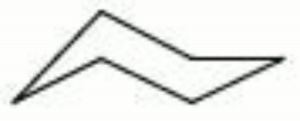Difference between revisions of "Cyclohexane"
Jump to navigation
Jump to search
| Line 9: | Line 9: | ||
[[[SliderGallery rightalign|aaiCYCLOHEXANE.jpg~FTIR|cyclohexane.jpg~Chemical structure]]] | [[[SliderGallery rightalign|aaiCYCLOHEXANE.jpg~FTIR|cyclohexane.jpg~Chemical structure]]] | ||
| − | == | + | == Risks == |
| + | |||
| + | * Highly flammable. Flashpoint = -18 C (0 F). | ||
| + | * May cause skin, nose and eye irritation. | ||
| + | * Acute exposure may cause narcosis. | ||
| + | * Cisco Chem: [http://www.ciscochem.com/assets/cyclohexane-sds.pdf SDS] | ||
| + | |||
| + | ==Physical and Chemical Properties== | ||
Miscible in ethanol, acetone, benzene, ether, carbon tetrachloride. Immiscible in water. | Miscible in ethanol, acetone, benzene, ether, carbon tetrachloride. Immiscible in water. | ||
| Line 22: | Line 29: | ||
|- | |- | ||
! scope="row"| Melting Point | ! scope="row"| Melting Point | ||
| − | | 6.5 | + | | 6.5 C |
|- | |- | ||
! scope="row"| Density | ! scope="row"| Density | ||
| − | | 0.7781 | + | | 0.7781 g/ml |
|- | |- | ||
! scope="row"| Molecular Weight | ! scope="row"| Molecular Weight | ||
| Line 34: | Line 41: | ||
|- | |- | ||
! scope="row"| Boiling Point | ! scope="row"| Boiling Point | ||
| − | | 80.7 | + | | 80.7 C |
|} | |} | ||
| − | |||
| − | |||
| − | |||
| − | |||
| − | |||
| − | |||
| − | |||
| − | |||
== Comparisons == | == Comparisons == | ||
Latest revision as of 14:11, 14 July 2022
Description
A colorless, strong smelling solvent whose structure is an aliphatic cyclic hydrocarbon. Cyclohexane is a common solvent that is used in the production of nylon. It dissolves many types of materials such as cellulose ethers, fats, oils, waxes, bitumens, natural resins, and rubber. Cyclohexane is often used in varnish and paint removers.
Synonyms and Related Terms
hexamethylene; hexanaphthene; hexahydrobenzene
Risks
- Highly flammable. Flashpoint = -18 C (0 F).
- May cause skin, nose and eye irritation.
- Acute exposure may cause narcosis.
- Cisco Chem: SDS
Physical and Chemical Properties
Miscible in ethanol, acetone, benzene, ether, carbon tetrachloride. Immiscible in water.
| Composition | C6H12 |
|---|---|
| CAS | 110-82-7 |
| Melting Point | 6.5 C |
| Density | 0.7781 g/ml |
| Molecular Weight | mol. wt.= 84.16 |
| Refractive Index | 1.424 |
| Boiling Point | 80.7 C |
Comparisons
Resources and Citations
- G.S.Brady, Materials Handbook, McGraw-Hill Book Co., New York, 1971 Comment: p. 744
- Michael McCann, Artist Beware, Watson-Guptill Publications, New York City, 1979
- The Merck Index, Martha Windholz (ed.), Merck Research Labs, Rahway NJ, 10th edition, 1983 Comment: entry 2792
- CRC Handbook of Chemistry and Physics, Robert Weast (ed.), CRC Press, Boca Raton, Florida, v. 61, 1980 Comment: ref. index = 1.424

